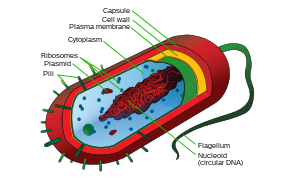http://en.wikipedia.org/wiki/Cell_(biology)
There are two types of cells, eukaryotes, which contain a nucleus, and prokaryotes, which do not. Prokaryotic cells are usually single-celled organisms, while eukaryotic cells can be either single-celled or part of multicellular organisms.
There are two types of cells, eukaryotes, which contain a nucleus, and prokaryotes, which do not. Prokaryotic cells are usually single-celled organisms, while eukaryotic cells can be either single-celled or part of multicellular organisms.
Prokaryotic cells
Prokaryotic cells were the first form of life on Earth. They are simpler and smaller than eukaryotic cells, and lack membrane-bound organelles such as the nucleus. Prokaryotes include two of the domains of life, bacteria and archaea. The DNA of a prokaryotic cell consists of a single chromosome that is in direct contact with the cytoplasm. The nuclear region in the cytoplasm is called the nucleoid.
A prokaryotic cell has three architectural regions:
- On the outside, flagella and pili project from the cell's surface. These are structures (not present in all prokaryotes) made of proteins that facilitate movement and communication between cells.
- Enclosing the cell is the cell envelope – generally consisting of a cell wall covering a plasma membranethough some bacteria also have a further covering layer called a capsule. The envelope gives rigidity to the cell and separates the interior of the cell from its environment, serving as a protective filter. Though most prokaryotes have a cell wall, there are exceptions such as Mycoplasma (bacteria) and Thermoplasma(archaea). The cell wall consists of peptidoglycan in bacteria, and acts as an additional barrier against exterior forces. It also prevents the cell from expanding and bursting (cytolysis) from osmotic pressure due to a hypotonic environment. Some eukaryotic cells (plant cells and fungal cells) also have a cell wall.
- Inside the cell is the cytoplasmic region that contains the genome (DNA), ribosomes and various sorts of inclusions. The prokaryotic chromosome is usually a circular molecule (an exception is that of the bacterium Borrelia burgdorferi, which causes Lyme disease).Though not forming a nucleus, the DNA is condensed in a nucleoid. Prokaryotes can carry extrachromosomal DNA elements called plasmids, which are usually circular. Plasmids encode additional genes, such as antibiotic resistance genes.

No comments:
Post a Comment